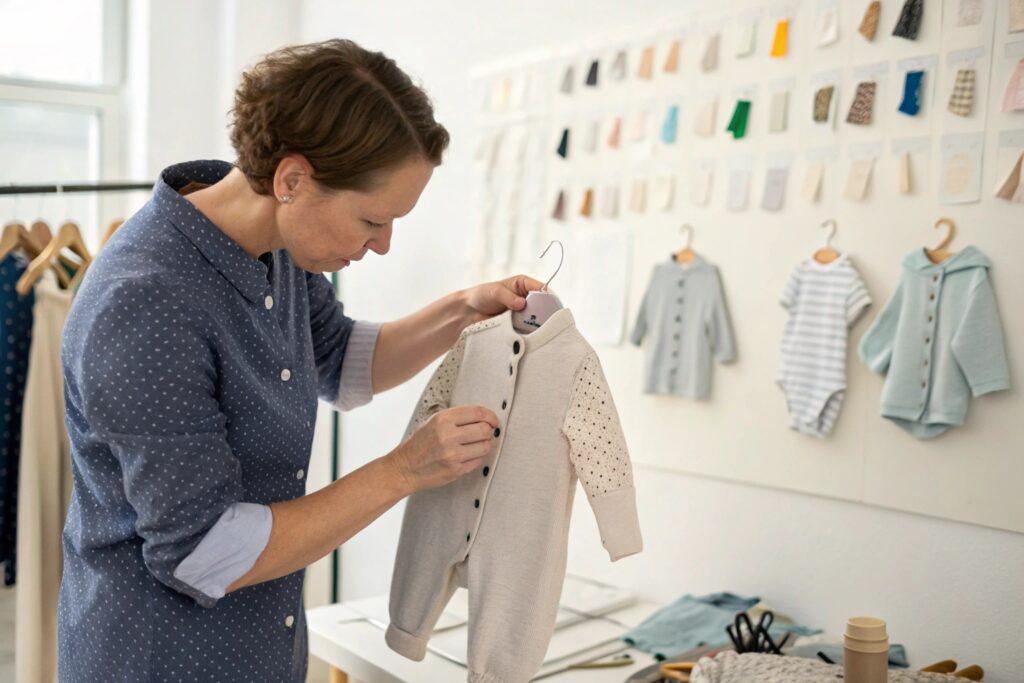Sustainability in the fashion industry has become a growing concern for consumers, especially for parents who want the best for their children. When it comes to babywear, finding the balance between eco-friendly practices and ensuring safety is critical. Baby clothing needs to meet strict safety standards to protect sensitive skin and overall well-being, but that doesn’t mean sacrificing sustainability. It is entirely possible for babywear brands to create products that are both environmentally friendly and meet the necessary safety standards.
How can sustainable babywear still meet safety standards?
Sustainable babywear can meet the necessary safety standards by choosing safer materials, eco-friendly dyes, and non-toxic manufacturing processes. By focusing on using organic cotton, wool, and other biodegradable fabrics, brands can create baby clothing that is both safe and environmentally responsible. Moreover, brands that are transparent about their manufacturing processes and certifications are gaining the trust of parents looking for responsible choices.
In this article, we will explore the key safety standards that infant clothing must meet, how to ensure sustainable practices align with those standards, and provide guidance on choosing baby clothes that are both safe and eco-friendly.
What safety standard should infant clothing meet?
Infant clothing must adhere to specific safety standards to ensure that it is safe for babies’ delicate skin and health. These standards are set by various regulatory bodies to minimize the risk of injuries or health issues caused by toxic substances, sharp objects, or improperly designed clothing.
What safety standard should infant clothing meet?
In many regions, baby clothing is subject to various safety regulations, which are intended to protect babies from potential hazards. In the U.S., for example, the Consumer Product Safety Commission (CPSC) sets strict guidelines for children’s clothing to prevent choking hazards, flammability risks, and exposure to harmful chemicals. Similarly, in Europe, baby clothing must meet the requirements of the European Union’s General Product Safety Directive (GPSD), which ensures that baby products are free from harmful substances and meet other safety criteria.
What are the key components of safety standards for infant clothing?
-
Flammability Standards: Baby clothing must meet specific flammability standards to ensure that garments do not catch fire easily. The CPSC, for example, requires that children’s sleepwear, including pajamas, be flame-resistant to prevent the risk of burns. In the EU, similar standards exist to ensure that baby clothing does not catch fire when exposed to open flames or heat sources.
-
Choking Hazards: Small parts like buttons, zippers, or decorative pieces on clothing must be securely attached to avoid posing a choking hazard to infants and toddlers. Additionally, drawstrings in clothing should be avoided or designed in a way that minimizes the risk of strangulation.
-
Chemical Safety: Infant clothing must be free of harmful chemicals such as formaldehyde, lead, and phthalates, which can irritate the skin or cause long-term health problems. Safety standards such as the OEKO-TEX Standard 100 ensure that baby clothes are free from harmful substances and safe for sensitive skin.
-
General Durability: Babywear must be durable enough to withstand regular washing and wear without falling apart or losing its integrity. This ensures that clothing does not pose a safety risk due to broken seams or weakened fabric.

Why are these safety standards so important?
Baby clothing safety standards are vital to ensure that infants are protected from preventable accidents and health risks. Babies are more vulnerable than adults, as their skin is thinner and more absorbent, and their immune systems are still developing. Clothing that does not meet these safety standards can expose babies to unnecessary dangers, from skin irritation caused by chemicals to the risk of suffocation or burns. Ensuring that babywear meets these standards helps parents feel confident that their children are dressed in safe, reliable clothing.
What are the safety tips for children’s clothing?
When purchasing clothing for babies and young children, it’s important to keep certain safety tips in mind. These tips help ensure that the clothing is comfortable, non-toxic, and appropriately designed for young children, minimizing the risk of accidents or health issues.
What are the safety tips for children’s clothing?
Here are some safety tips that parents and caregivers should consider when buying baby and children’s clothing:
-
Avoid Small, Detachable Parts: Ensure that clothing items do not have small buttons, beads, or other detachable parts that could be a choking hazard. Opt for clothing with secure fasteners or avoid decorative items entirely.
-
Choose Soft, Breathable Fabrics: Look for clothing made from soft, breathable fabrics like organic cotton or bamboo that allow the skin to breathe and prevent overheating. Avoid synthetic fabrics that may irritate delicate skin.
-
Opt for Flame-Resistant Sleepwear: Always choose flame-resistant or flame-retardant sleepwear for babies, especially when buying pajamas. Flame-resistant materials reduce the risk of injury in case of an accidental fire.
-
Check for Tight Waistbands or Drawstrings: Tight waistbands or drawstrings in baby clothing should be avoided as they can cause discomfort, or worse, a choking or strangulation hazard. Look for elastic waistbands or adjustable options instead.
-
Follow the Care Label: Always follow the care instructions on clothing labels to ensure that garments maintain their integrity after washing. Proper care can help preserve the safety and durability of the clothing, ensuring it remains comfortable and functional for longer.
How can sustainable babywear also be safe?
Sustainable babywear can be safe if manufacturers follow the same safety standards applied to conventional clothing while ensuring their materials and production processes are eco-friendly. Organic cotton, wool, and hemp are all natural materials that are biodegradable and free from toxic pesticides, making them a safer choice for babies. Furthermore, using natural dyes and chemical-free finishes ensures that harmful residues are not left behind.
What is the safest material for baby clothes?
When it comes to babywear, selecting the right fabric is essential. Babies have sensitive skin, so the materials that come into contact with their skin should be soft, gentle, and free from harmful chemicals.
What is the safest material for baby clothes?
-
Organic Cotton: Organic cotton is one of the safest and most popular materials for baby clothing. It is grown without harmful pesticides or chemicals, making it a safer option for babies with sensitive skin. Organic cotton is soft, breathable, and durable, and it is also biodegradable, making it a sustainable choice.
-
Bamboo: Bamboo fabric is naturally hypoallergenic, breathable, and moisture-wicking. It is also eco-friendly, as bamboo grows quickly without the need for pesticides. Bamboo fabric is soft and gentle on a baby’s skin, making it an ideal material for baby clothes.
-
Wool: Wool is a natural material that is both warm and breathable. Organic wool is a sustainable choice, as it is biodegradable and does not require chemical pesticides for production. Wool is also naturally flame-resistant, making it a safe option for baby clothing.
-
Hemp: Hemp fabric is another eco-friendly option that is safe for babies. It is naturally resistant to mold and bacteria, which can help prevent skin irritation. Hemp is also durable and becomes softer with each wash, making it ideal for long-lasting babywear.

Why should we choose organic or natural fabrics for babies?
Choosing organic or natural fabrics for babywear ensures that no harmful chemicals or pesticides are used in the production process, reducing the risk of skin irritation, allergic reactions, or exposure to toxic substances. Organic and natural fabrics are typically softer, more breathable, and more comfortable for babies, making them a safer and more sustainable choice for parents who care about both their baby’s health and the environment.
What are 4 guidelines for choosing children’s clothing?
When selecting clothing for children, especially babies and toddlers, parents should keep the following four guidelines in mind to ensure their clothes are safe, comfortable, and environmentally friendly.
What are 4 guidelines for choosing children’s clothing?
-
Prioritize Comfort and Fit: Ensure the clothing fits well and doesn’t have tight elastic bands or seams that could cause discomfort or restrict movement. Babies should be able to move freely and comfortably in their clothes.
-
Select Non-Toxic, Safe Materials: Opt for babywear made from organic, chemical-free fabrics like organic cotton, bamboo, or wool. These materials are gentle on the skin and free from harmful chemicals, which is essential for baby’s sensitive skin.
-
Check for Safety Certifications: Look for clothing that meets safety certifications, such as OEKO-TEX Standard 100 or GOTS (Global Organic Textile Standard). These certifications ensure that the clothing is free from harmful chemicals and meets safety requirements for children’s wear.
-
Durability and Washability: Choose baby clothes that are durable and easy to wash. Babies can be messy, so clothes that can withstand frequent washing without fading, shrinking, or losing their shape are more practical and cost-effective in the long run.
Why are these guidelines important?
By following these guidelines, parents can ensure their babies are wearing clothing that is not only comfortable and stylish but also safe and eco-friendly. Clothing made from safe, non-toxic materials reduces the risk of skin irritation or exposure to harmful chemicals, while choosing clothes that are durable and easy to care for ensures long-term use.
Conclusion
Sustainable babywear can meet safety standards without compromising on comfort or eco-friendliness. By focusing on safe, non-toxic materials such as organic cotton and bamboo, babywear brands can offer clothing that is gentle on babies’ delicate skin and better for the environment. By following proper safety standards, prioritizing comfort, and selecting certified materials, parents can be assured that their children’s clothing is both safe and sustainable.










